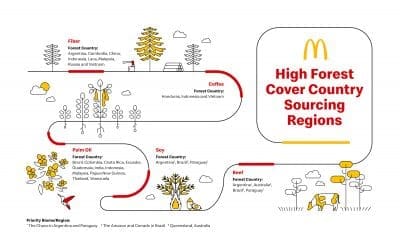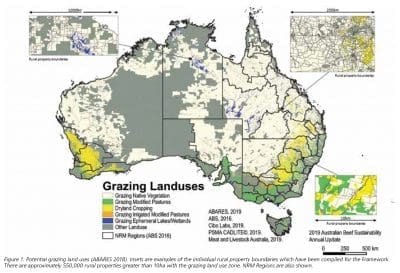2020 is the year many downstream customers of Australia’s beef industry – and all beef producing countries for that matter – have committed to removing or reducing ‘deforestation’ from their supply chains.
The commitments have been made in a variety of global forums over the past five years including the New York Declaration on Forests, the UN Sustainable Development Goals (SDGs) and the Consumer Goods Forum.

This McDonald’s infographic includes Queensland as one of a number of ‘high forest cover sourcing regions’ for beef around the world. Click on image to enlarge.
Included is Australia’s single largest beef customer, McDonald’s, which has committed to eliminate deforestation from the supply chains from which it sources beef, among other products, by the end of this year, ahead of totally eliminating deforestation from its supply chains by 2030.
It’s clear most companies are not going to meet the 2020 deadline, but the commitments and the intent remain in place.
Beef Central has asked McDonald’s Australia to elaborate on how its work to meet that commitment is progressing but has not yet received a response.
Against this backdrop, the inclusion of a definition of what comprises a ‘forest’ in the last two ASBF annual updates has generated some angst in parts of the beef industry, particularly in Queensland and New South Wales, where landholder rights to manage vegetation have been subjected to increasingly more restrictive regulatory controls from State Governments in recent decades.
In the last two Australian Beef Sustainability Framework annual updates the following definitions for woodland and forest have been listed:
– woodland is “vegetation with 5-20pc canopy cover”, and,
– forest is “woody vegetation with >20pc canopy cover reaching 2m high with a minimum area of 0.2 hectares”.
The Sustainability Steering Group overseeing the Framework emphasises that it does not set policy for industry and that where targets or goals appear in its annual updates they reflect an agreed position of industry bodies.
It is not clear what the background is in terms of which red meat industry groups originally agreed to the definitions listed. Cattle Council of Australia has told Beef Central the definition is not one of its policies.
Some producers have voiced concern that the inclusion of a definition that classifies forest as an area with as little as 20 percent canopy cover, and just two metres high, amounts to their own industry bodies agreeing to or accepting restrictions on behalf of producers that will make it impossible to manage regrowth to protect grasslands and will in effect regulate them out of their own industry.
Queensland cattle producer and property rights advocate Ashley McKay highlighted his concerns about the forest definition in a letter to media last week, which he said overturned 200 years of interpretations on what constituted a forest by Collins, Oxford and Cambridge dictionaries.
“In this ‘new forest’ no eagle can build a nest, no koala can sit in a fork, no possum can find a hollow, no goanna can climb to safety, no bee can lodge it’s honeycomb and a rider on horseback sticks out the top,” he wrote.
“But if a cattle levy payer dares to clear this growth, within the laws of the Commonwealth or the States, then they are deemed guilty of ‘deforestation’ by our ‘green colleagues’ and can be banned from the cattle supply chain.”
However the Sustainability Steering Group stresses it does not set industry policy and that information around woodland and forest has been included for the purpose of addressing the persistent movement between vegetation classes.
So far, the data shows woody vegetation in Australia’s grazed agricultural lands overall is increasing, not decreasing.
Over the last decade, it shows Australia has also seen a general increase in the density of woodland areas through a transition from woodland to forest.
Trends in the primary woody vegetation removal have declined by more than 90 percent from 1990 level.
Since 2009 the national annual removal rate has been less than 0.3pc. These losses include fires and commercial forestry on private land, so overestimate annual losses from grazing enterprises.
It is understood the definitions for woodland and forest included in the 2019 and 2020 ASBF annual updates align with prior definitions developed by the United Nation’s Food and Agriculture Organisation (FAO).
Since that time FAO has reclassified its definition of forest to just “10pc canopy cover”.
The steering group says the ABSF has not applied that new FAO reclassification and remains consistent with the Department of Agriculture, Water, and the Environment.
The 2020 annual report notes that since 2019 the steering group has been working with a specialist agricultural data analytics company (Cibo Labs) to analyse publicly available satellite imagery and to develop the capability to measure and monitor changes in tree and grass cover.
“By continuing to demonstrate that productivity and healthy landscapes coexist, the industry can work towards minimising regulation,” the update states.
It says more than three decades of publicly available satellite imagery can now be drawn upon is readily available.
As explained in this deeper dive article on the ASBF website, the aim is to ensure “every producer has equal access to key data being compiled by government agencies on their properties; access to the latest publicly available satellite data; and most importantly, the tools to bring the information together to support on-ground and strategic management decisions for individual producers and the broader industry”.

